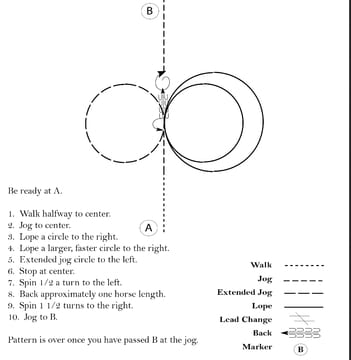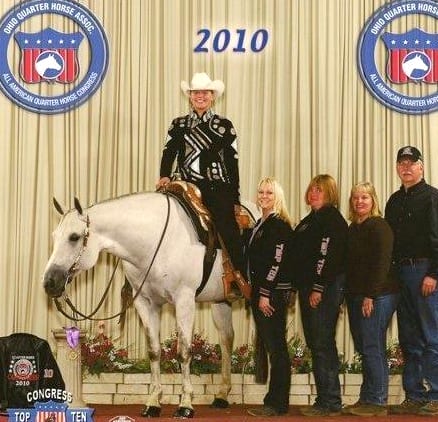First up in our Congress pattern series is AQHA Judge Lori Gordon of Washington, Pennsylvania breaking down the Congress Youth Horsemanship 15-18 pattern. Gordon just finished judging the first-ever AQHA East Coast Novice Championship Show, and she has also judged World Shows for AQHA, NSBA, APHA, PHBA, and ApHC. Gordon specializes in helping youth and amateurs develop their riding skills where she has coached several clients to Top 5 Congress wins and World Show placings.
We would also like to thank HorseShowPatterns.com for letting us post the pattern in the article. Please print out the pattern and follow along if that would be easier.
As far as why GoHorseShow chose the 15-18 Youth Horsemanship pattern, we wanted to breakdown the harder patterns due to the easier patterns having many of the same maneuvers.
Major Tips from Lori Gordon:
- In Horsemanship, I look for the rider that has the best equitation and that can maneuver their horse smoothly throughout the pattern. In a perfect run, these two things should work in unison.
- In this pattern, I would look for the rider to be alert at cone A and ready to move forward when directed–with the horse in the bridle and rider straight but not stiff throughout their body. Horse and rider should then move off in a straight line at the walk then promptly pick up a nice cadenced, even-paced jog halfway to the center. Straight lines are a must and the rider should look forward, heels down, correct line through shoulder, hip, heel (foot not too far in stirrup just on the ball of the foot) and natural correct arm carriage. Reins should have contact with the horse’s mouth for guidance and control throughout the pattern. Not too tight and not too loose. I determine the rider’s rein length on what length is best for that particular horse to get the best go and be the most responsive to hands, legs, seat and voice.
 The decision on when to cue the horse into the first lope circle is also based on that individual horse and how responsive or dull he may be to the rider’s cue. I may have the rider cue a light sided horse just one stride away from center whereas a less responsive animal may need to start receiving cues from the rider two or three strides away from point of transition. Keeping this in mind and upon reaching the center, I look for the horse to respond to the rider’s cue when asked to lope off with an immediate departure, responsive and soft in the bridle for a very round, controlled, rhythmic circle followed by another larger faster symmetrical circle with obvious speed and size variation. I always tell my riders to move their hand just slightly forward in the larger circle to show more forward movement and increase in speed. Very important to me would be closing all circles at the same spot which shows planning and correct steering ability. Throughout the entire execution of the pattern proper equitation should stay intact.
The decision on when to cue the horse into the first lope circle is also based on that individual horse and how responsive or dull he may be to the rider’s cue. I may have the rider cue a light sided horse just one stride away from center whereas a less responsive animal may need to start receiving cues from the rider two or three strides away from point of transition. Keeping this in mind and upon reaching the center, I look for the horse to respond to the rider’s cue when asked to lope off with an immediate departure, responsive and soft in the bridle for a very round, controlled, rhythmic circle followed by another larger faster symmetrical circle with obvious speed and size variation. I always tell my riders to move their hand just slightly forward in the larger circle to show more forward movement and increase in speed. Very important to me would be closing all circles at the same spot which shows planning and correct steering ability. Throughout the entire execution of the pattern proper equitation should stay intact.
- Upon closing the second circle, the downward transition to the jog should be smooth and subtle with the horse being cued to jog and within a stride or two move directly onto the extended jog. Sometimes trying to initiate this transition too quickly results in a break of gait or a rough transition. Get the jog gait and then immediately move into your extension. The horse and rider team should show correct body position, hitting the middle spot and smoothly steering to an extended jog circle to the left. Legs and seat should be adhere to the horse being ready to cue for each maneuver and helping to maintain proper body posture. This is followed by a straight stop in the same spot in the center of the pattern, with the rider maintaining correct position and the horse stopping underneath himself and not falling forward into the stop.
- The 1/2 turn to the left should be executed with the horse’s front legs crossing over each other and the horse sitting on the inside hind to pivot, followed by backing one horse length, again in a nice straight line with no resistance from the horse and no excessive hand use by the rider. The length of the back should depend on the horse’s body size and structure. A larger animal will cover more ground when backing. Approximately 4-5 strides when not denoted in pattern will suffice. If you are not sure and the pattern does not designate how many steps, it is always better to back that extra step to show completion of the maneuver rather than falling short of fulfilling the maneuver requirement. The horse and rider execute 1 1/2 turns to the right in which I like to see the rider keeping hands the same distance apart and having head, shoulders and arms all working smoothly for a pretty, correct turn in alignment and if possible with speed–although never sacrifice correctness for speed. Master the exercise then add your speed.
- Next, the horse and rider jog to B in a straight line, and a smooth transition into the jog from the turn should be prompt and effortless bleeding immediately into the jog and continuing in a straight line until passing B. The pattern is over once B is passed at the jog. I like to see a horse that is the same distance from both the beginning cone of the pattern and the end cone of the pattern and hits the same middle spot when closing the circles in this pattern. Continue to jog past cone B and exit. You do not need to acknowledge the judge when exiting.
- We prepare for horsemanship at home by practicing the maneuvers both in patterns and separating the maneuvers and doing them one by one. At the show when practicing in the arena, you can get a feel for the size your pattern will be so as to best show your horse. At this time we also pick outside boundaries to determine the size of our circles both at the jog and lope and build an imaginary wall that we do not want to go beyond to control the size of our circles. Always remembering that many horses like to fall in and make a circle flat, we will probably need to add space by steering out in order to keep the circles round, even and symmetrical. Before you go in to show you can look at the two cones and decide where the center is and where you want to hit that middle spot each time when finishing your circles. Also we practice straight lines and circles in all gaits both regular and extended always keeping the correct cadence and speed for your own horse and different size circles in varying speeds both on the correct lead and counter cantering for control.
- As for any pattern, we would remind our customers to look up and never quit riding, even if at some point something doesn’t go as planned, always ride to the best of your ability to the end. And most importantly have fun and enjoy the ride!
*Stay tuned for AQHA Judges Stephanie Lynn breaking down the Equitation and Tina Anderson the Showmanship! Please also check out our other articles below relating to horsemanship and other pattern classes.







